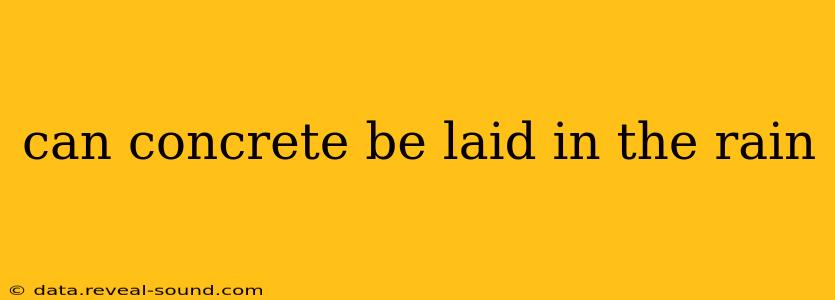Laying concrete is a crucial step in many construction projects, and the weather plays a significant role in its success. One common question among homeowners and contractors alike is: can concrete be laid in the rain? The short answer is complicated, and depends on several factors. While it's not impossible, pouring concrete in the rain often leads to compromised strength and durability, and can even be dangerous. Let's delve into the details.
What Happens When Concrete Gets Wet Before Curing?
Rainwater significantly impacts the curing process of concrete. Concrete cures through a chemical reaction called hydration, where cement powder reacts with water to form a hard, stone-like mass. Excessive water from rainfall can disrupt this process in several ways:
-
Washed-Out Cement: Rain can wash away the cement paste, leaving behind a weaker concrete mixture. This weakens the overall structure and reduces its long-term durability.
-
Delayed Setting Time: Dilution of the concrete mix with rainwater can slow down the setting process, making the concrete more susceptible to damage before it gains sufficient strength.
-
Surface Defects: Rain can create surface imperfections like pitting and discoloration. These aren't just cosmetic; they weaken the concrete's protective layer, increasing susceptibility to cracking and deterioration.
-
Reduced Strength and Durability: Ultimately, the most significant concern is reduced strength and durability. Concrete laid in heavy rain is more prone to cracking, spalling (chipping or flaking), and premature failure.
Can You Lay Concrete in Light Rain?
The intensity of the rain is a critical factor. A light drizzle might seem inconsequential, but even this can cause issues. While it might not completely wash away the cement, the extra moisture can still slow down curing and potentially introduce impurities. The best practice is to avoid pouring in any rain, regardless of intensity.
What About Using a Tarp to Protect Fresh Concrete?
While tarps can offer some protection from light rain, they are not a foolproof solution. The tarp might not be able to cover the entire pour, allowing some areas to be exposed. Moreover, wind can lift or tear the tarp, leaving the concrete vulnerable. Finally, trapped moisture under the tarp can still hinder the curing process. A tarp is a temporary fix at best.
How Much Rain is Too Much?
There's no magic number of inches of rain that determines if pouring concrete is safe. Even a short period of moderate to heavy rainfall can have detrimental effects. The decision should be based on the forecast and your assessment of the weather conditions. If there's any doubt, postponing the pour is always the safest course of action.
What are the Best Conditions for Laying Concrete?
Ideal conditions for laying concrete include:
- Dry weather: This is the most important factor. Avoid pouring if rain is expected.
- Moderate temperatures: Extreme heat or cold can negatively affect curing.
- Low wind: Wind can dry out the surface too quickly, leading to cracking.
- No direct sunlight: Direct sunlight can cause the surface to dry too quickly, also leading to cracking.
What are the alternatives if it rains?
If rain is in the forecast, consider postponing your pour. Reschedule for a day with favorable weather conditions. Proper planning and a flexible schedule are essential for successful concrete work.
By understanding the potential risks and prioritizing optimal conditions, you can ensure a strong and durable concrete structure for years to come. Remember, the cost of redoing poor concrete work far exceeds the cost of delaying a pour.
